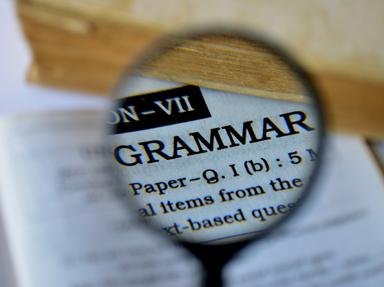Quiz Answer Key and Fun Facts
1. GENERAL TYPOGRAPHY: The pilcrow symbol looks like a backwards P. What unit of text does it usually introduce?
2. MATHEMATICS: Experts in calculus use a special symbol called the nabla to represent gradients. The nabla is an inverted triangle, known in its "right side up" form as what Greek letter?
3. LANGUAGES: The caron, or haček, is a diacritic mark that looks like a little v above a letter. Which of these written languages would most likely use carons in spelling its written words?
4. MUSIC: What should string players do when they see a square bracket above a note? (The symbol looks a little like an inverted square U with a thick crossmember.)
5. COMMERCE: Consumers may find the estimated symbol on products whose total net contents have been "estimated," as opposed to having been precisely measured. What does the estimated sign look like?
6. ASTROLOGY: The written symbols for the twelve signs of the zodiac are fascinating, exotic, and mysterious. What sign is represented by two squiggly or jagged lines, one above the other?
7. PUNCTUATION: Readers in many countries are accustomed to double quotation marks that look "like this." Elsewhere, printed materials (in France, for example) may instead contain guillemets that set off certain portions of text. What do guillemets MOST closely resemble?
8. CURRENCY: Once upon a time, one of the countries listed below used a capital C with a little r inside it to represent its currency, the Cruzeiro. Which country, before eventually replacing them with the Real, used Cruzeiros?
9. MEASUREMENT: If you have read blueprints, you may have seen a symbol referring to holes that need to be made in objects. The symbol looks a bit like an O with a diagonal slash through it. How is this symbol interpreted?
10. LANGUAGES: Some German words are spelled with a letter called Esszet or scharfes S. A variant of the two-letter combination ss, English speakers may call this letter the sharp S. What other letter or character does the Esszet most closely resemble?
11. PHONETICS: Language experts have compiled numerous systems of symbols that represent the many sounds the human voice can produce. A symbol common to several of these systems is the Greek letter theta. When transcribed into standard phonetic symbols, which of these English words would contain a theta? (Hint: voiceless interdental fricative, occurring medially.)
12. MUSIC: Readers of sheet music may encounter a symbol called a segno (Italian: sign). It looks like a partially rotated S with a diagonal slash and two dots. What does the segno tell the player?
13. CURRENCY: What country uses a capital Y with two horizontal strokes through it to represent the money used there?
14. MATHEMATICS: Vector calculus wizards use a symbol that looks like an upside-down sans serif capital T to signify that two vectors are orthogonal to one another. What related concept does the same symbol denote in geometry?
15. MEASUREMENT: Primes may be seen describing units of time, length, angle, musical pitch, or other measurements. What punctuation mark is the single prime most often confused with?
Source: Author
celicadriver
This quiz was reviewed by FunTrivia editor
looney_tunes before going online.
Any errors found in FunTrivia content are routinely corrected through our feedback system.
